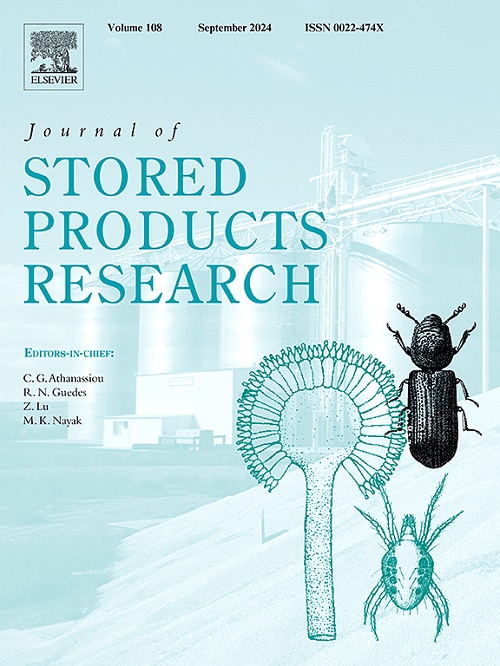Effectiveness of storage facilities in managing toxigenic fungi and mycotoxins associated with stored maize (Zea mays L.) in Ethiopia
IF 2.7
2区 农林科学
Q1 ENTOMOLOGY
引用次数: 0
Abstract
Improved post-harvest handling of maize grain is an important activity to reduce fungal infection and mycotoxin contamination. This study aimed to evaluate the effectiveness of different storage facilities in managing toxigenic fungi and mycotoxins. The experiment was conducted from December 2020 to Augst 2021 at Jimma University with two storage types: storage bags (AgroZ®, fertilizer, jute, polypropylene, and PICS bag) for shelled maize, and Gombisa (traditional and modified) for maize cobs. Gombisa is cylindrical granary storage facility. Constant temperature and relative humidity were recorded in PICS, AgroZ®, and fertilizer bags, and consistent temperature in modified Gombisa. The toxigenic fungi detected in this study included Aspergillus, Fusarium and Penicillium species. Fungal infection incidence, grain germination and moisture content were highly significantly (P < 0.001) influenced by the interaction of storage facilities and duration of storage in both experiments. The highest incidences of toxigenic fungi were recorded in polypropylene and jute bags after 2nd and 4th months in the traditional Gombisa respectively. There was a significant positive correlation (P < 0.001) among storage duration and incidence of toxigenic fungi. Twenty-two mycotoxins were detected in the maize grains stored for eight months, with Fusarium metabolites being the most dominant. Fumonisins B1, B2, B3 and B4, and DON, ZEN and NIV were detected from loading time up to 8th month. Low fungal incidences, highest grain germination percentage, and low mycotoxin contamination were recorded in PICS, fertilizer bag and modified Gombisa. Thus, the study affirmed the effectiveness of PICS, fertilizer bags, and modified Gombisa in reducing mold and mycotoxin contamination under stored maize grain.

埃塞俄比亚储存设施管理与储存玉米(Zea mays L.)有关的产毒真菌和真菌毒素的有效性
改进玉米收获后处理是减少真菌感染和霉菌毒素污染的重要措施。本研究旨在评估不同储存设施在处理产毒真菌和真菌毒素方面的有效性。试验于2020年12月至2021年8月在吉马大学进行,采用两种储存方式:用于脱壳玉米的储存袋(AgroZ®、肥料、黄麻、聚丙烯和PICS袋)和用于玉米芯的Gombisa(传统和改良)。冈比萨是圆柱形的粮仓储存设施。在PICS、AgroZ®和肥料袋中记录恒定的温度和相对湿度,在改性Gombisa中记录恒定的温度。本研究检出的产毒真菌包括曲霉、镰刀菌和青霉。真菌侵染率、籽粒发芽率和水分含量极显著(P <;0.001),受到两个实验中储存设施和储存时间的相互作用的影响。在传统贡贝中,聚丙烯袋和黄麻袋在第2个月和第4个月的产毒真菌发病率最高。两者有显著正相关(P <;0.001)。在贮藏8个月的玉米籽粒中检测到22种真菌毒素,其中镰刀菌代谢产物占主导地位。装药至8个月时检测富马菌素B1、B2、B3和B4, DON、ZEN和NIV。PICS、肥袋和改良贡贝的真菌发病率低,籽粒发芽率高,霉菌毒素污染低。因此,本研究肯定了PICS、肥袋和改性Gombisa在减少玉米贮藏下霉菌和霉菌毒素污染方面的有效性。
本文章由计算机程序翻译,如有差异,请以英文原文为准。
求助全文
约1分钟内获得全文
求助全文
来源期刊
CiteScore
5.70
自引率
18.50%
发文量
112
审稿时长
45 days
期刊介绍:
The Journal of Stored Products Research provides an international medium for the publication of both reviews and original results from laboratory and field studies on the preservation and safety of stored products, notably food stocks, covering storage-related problems from the producer through the supply chain to the consumer. Stored products are characterised by having relatively low moisture content and include raw and semi-processed foods, animal feedstuffs, and a range of other durable items, including materials such as clothing or museum artefacts.

 求助内容:
求助内容: 应助结果提醒方式:
应助结果提醒方式:


